A 2005 Brookings Institution report predicted that by 2030, half of the buildings in the U.S. will have been constructed after 2000. Think of it: The volume of construction in the first few decades of this century will match the entire remains of the previous two centuries. For green building advocates, this revelation highlights the urgent need to improve the quality of new construction. But what of the old?
“There’s a perception that working on a historic building will be a stranglehold on the designer,” laments Meghan Kleon, a University of Texas doctoral candidate studying the intersections between historic preservation and sustainable design. “But preservation isn’t just about gray-haired old ladies making house museum shrines.” She’s quick to point out that ensuring the long-term viability of the built environment—new and old—will take great imagination and foresight.
“Preservation is the avant-garde of sustainability,” declares Susan Piedmont-Palladino, curator at the National Building Museum. “It was the preservationists who first ventured the radical thought that there might be other criteria for value in the built environment than pure utility or economic return, that buildings and neighborhoods might be valuable because they have received generations of human energy and care.”
Kleon agrees: “In order to sustain something, a community has to want to keep it alive. Someone has to care for it. I sometimes wonder if architects really think about how buildings today will look, feel, and function in 25 or 50 or 100 years.”
The most imaginative architects do. “Our greatest responsibility is not to make new things—it’s to rethink the things we still have,” says Stephen Kieran of KieranTimberlake Associates. Although the firm is best known for innovative techniques in new construction, its website also includes an entire section devoted to conservation, populated by two dozen adaptive-reuse projects, including the beautifully renovated historic dormitories at Yale and Princeton. “If we really want to change energy and resource consumption quickly, and we must,” says Kieran, “then we all have an ethical responsibility to improve the performance of what we have already brought into the world.”
For designers accustomed to creating new things, reimagining what already exists will take a revolutionary mindset. After all, the most radical—and responsible—thing an architect can do is not build.
